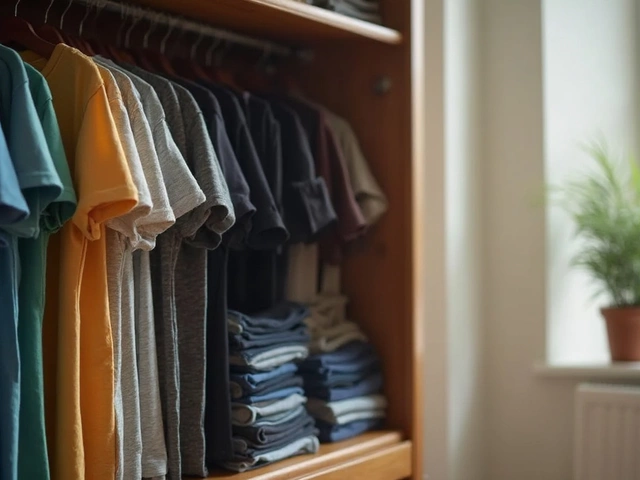When we think about school uniforms, the image that often comes to mind is a sea of students dressed identically, moving through the corridors. But there's more to this tradition than meets the eye. School uniforms have been a topic of debate for years, with opinions divided on their impact on students' education and social environment.
At the heart of the discussion is the idea that uniforms can level the playing field, making all students appear equal regardless of their background. This visual equality can help reduce bullying and social pressures related to fashion and wealth. It's not just about clothes; it's about creating an environment where students can focus on learning rather than competing over outfits.
Moreover, uniforms can significantly reduce morning stress for both parents and children. Deciding what to wear each day can be a time-consuming process, but with uniforms, the decision is made for you. This simplicity can lead to smoother mornings, more time for breakfast, and a better start to the school day.
As we explore the various facets of school uniforms, it's clear that their impact extends beyond the aesthetic. They can play a crucial role in shaping a school's culture, enhancing students' focus, and even saving families time and money. Let's dive deeper into the benefits and considerations of school uniforms, shedding light on why they might be more than just a dress code requirement.
- Promoting Equality Among Students
- Reducing Distractions in the Classroom
- Fostering School Spirit and Unity
- Practical Benefits for Families
Promoting Equality Among Students
One of the most compelling arguments for school uniforms is their ability to promote equality among students. In a world where social status and economic background can significantly influence a child's school experience, uniforms serve as a great equalizer. They strip away the visual markers of wealth and poverty, making it harder for students to judge or be judged based on their clothing. This is not just an idealistic view; research supports the notion that uniforms can reduce instances of bullying and social stratification within schools.
Consider the morning routine in households across the country. In homes without uniform policies, children often spend considerable time choosing outfits that will make them fit in or stand out. This daily decision can be fraught with anxiety, especially for those who cannot afford the latest trends. Uniforms eliminate this pressure, ensuring that all students start their day on equal footing. It's a simple change that can have profound effects on a child's self-esteem and social interactions.
Moreover, uniforms can help bridge the gap between students from diverse backgrounds. In schools with a wide range of socioeconomic statuses, the disparity in clothing can become a glaring indicator of inequality. Uniforms mask these differences, fostering a more inclusive environment. This inclusivity is crucial for creating a positive school culture where students feel valued for who they are, not what they wear.
According to a study published in the Journal of Educational Research, schools that implemented uniform policies reported a significant decrease in bullying incidents related to clothing.
"Uniforms can serve as a powerful tool in combating bullying and promoting a more harmonious school environment,"the study concluded. This finding underscores the role of uniforms in not just leveling the playing field but also in protecting students from the negative effects of social competition.
Uniforms also encourage a sense of belonging and community. When everyone dresses alike, it's easier to focus on what unites students rather than what divides them. This sense of unity is particularly important in fostering school spirit and pride. It's a reminder that despite their differences, students are part of a larger group with shared goals and values.
While the benefits of uniforms in promoting equality are clear, it's also important to consider the practical aspects. For families, uniforms can be a cost-effective solution to the ever-changing demands of fashion. Instead of purchasing an entire wardrobe of school clothes, parents can invest in a few sets of uniforms. This not only saves money but also simplifies the morning routine, making life easier for both parents and children.
In conclusion, the adoption of school uniforms is more than just a matter of dress code; it's a step towards creating a more equitable and inclusive educational environment. By minimizing the focus on clothing, schools can redirect attention to what truly matters: learning, growth, and the development of a strong, supportive community. The evidence is clear: when it comes to promoting equality among students, uniforms are a powerful tool in any school's arsenal.

Reducing Distractions in the Classroom
One of the most compelling arguments for school uniforms is their ability to minimize distractions in the classroom. Imagine a typical morning routine without uniforms: students might spend a significant amount of time choosing outfits, comparing brands, or even worrying about how they look compared to their peers. This focus on attire can easily carry over into the school day, diverting attention from what truly matters—learning. By standardizing what students wear, uniforms remove a layer of social competition and allow the classroom environment to be more centered on educational goals.
Studies have shown that when students wear uniforms, teachers spend less time addressing dress code violations or mediating arguments over clothing. This means more time can be devoted to instruction and engaging activities. For instance, a report from the National Association of Elementary School Principals found that schools with uniform policies reported fewer disciplinary issues related to clothing. This isn’t surprising when you consider how much time and energy can be wasted on debates about what’s appropriate to wear. Uniforms simplify these decisions, letting everyone focus on the task at hand.
Another way uniforms reduce distractions is by eliminating the pressure to keep up with fashion trends. In schools without uniforms, students often feel compelled to wear the latest styles or brands to fit in. This can lead to feelings of inadequacy or even financial strain for families who can’t afford trendy clothes. A study by the University of Houston highlighted that students in schools with uniform policies reported lower levels of stress and anxiety related to their appearance. As one student put it,
‘When everyone looks the same, you don’t have to worry about standing out for the wrong reasons.’
Uniforms also help create a more professional atmosphere in schools. When students dress in a uniform, it signals that they are there to learn, much like how employees wear uniforms or business attire to signify their roles. This subtle shift in mindset can make a big difference in how students approach their education. It’s not just about looking the part—it’s about feeling it too. Teachers often report that students in uniforms are more focused and less likely to engage in off-task behaviors, such as fidgeting with their clothes or adjusting their outfits during class.
Let’s not forget the practical side of things. Without uniforms, mornings can be chaotic as students scramble to put together an outfit that’s both stylish and acceptable under the school’s dress code. This can lead to tardiness, stress, and even arguments at home. Uniforms streamline this process, giving students one less thing to worry about. For parents, it’s a relief to know their child’s clothing won’t be a source of conflict or distraction during the school day. This simplicity can translate into better attendance and punctuality, which are key factors in academic success.
While some argue that uniforms stifle individuality, the reality is that they create a level playing field where students can express themselves in other ways—through their ideas, creativity, and achievements. By removing the visual distractions of varying clothing styles, uniforms allow students to focus on what truly matters: their education. As schools continue to explore ways to enhance the learning environment, the role of uniforms in reducing distractions cannot be overlooked. Whether it’s through fewer dress code issues, less social pressure, or a more professional atmosphere, uniforms have the potential to make classrooms more conducive to learning.





